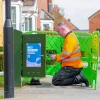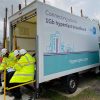BT Group and EE UK Switch-On First Self-Powered 5G Mobile Site

Broadband ISP and mobile operator EE (BT) has today become the latest network operator to switch-on a self-powered 4G and 5G (broadband) mobile site, which uses a mix of solar power and a wind turbine to help support its operation in a remote rural area of the Shropshire Hills (England). The deployment represents a trial, but more could follow.
The idea of using on-site renewable energy sources to power mobile masts is nothing new and, indeed, we still haven’t forgotten Vodafone’s upside down lawnmower approach from 2022 (here). EE states that 100% of their trial site’s power requirements will similarly be delivered by renewable energy sources, 70% of which are generated by on-site solar and wind.
The trial site, which was identified through an environmental assessment, also features battery storage that will help to keep it powered during the night and other periods of low wind or solar generation. In the event of there being an insufficient renewable energy source available and the battery power being fully discharged, a generator powered by Hydrotreated Vegetable Oil (HVO) fuel will act as a backup (HVO is classed as a green fuel).
Advertisement
BT said they expect the site to deliver approximately 17,000kWh of wind and solar energy per year, as well as cost savings upwards of £10k. The savings are important because building all of that new kit is going to be expensive and will need to pay for itself over the medium to longer-term in order to be viable. Not to mention the need to replace the kit as it reaches end-of-life.
Greg McCall, BT Group’s Chief Networks Officer, said:
“Delivering ubiquitous coverage is critically important in an age where connectivity has never been so central to everyday life, but it absolutely must be done in a responsible and sustainable manner. It’s paramount that we increase the energy-efficiency of our networks, and so we’re really excited about the potential of self-powering sites in enabling us to meet both our sustainability and connectivity ambitions.”
While the Shropshire Hills site serves as a trial, BT says they’ve already identified “hundreds of additional locations“, which have the “potential” to derive much of their power from on-site renewable sources, in particular in coastal or hilly locations. But such sites will also require more space, which can cause problems for private landowners and may increase the cost and complexity of related wayleaves. Time will tell how many are actually viable to build.
Mark is a professional technology writer, IT consultant and computer engineer from Dorset (England), he also founded ISPreview in 1999 and enjoys analysing the latest telecoms and broadband developments. Find me on X (Twitter), Mastodon, Facebook, BlueSky, Threads.net and Linkedin.
« City-focused UK Broadband ISP Hyperoptic Appoints New Product Director























































Well done, BT. Good to see things like this happening. The energy transition is really gathering pace now, with huge developments in green generation, grid upgrades and storage. Anything that helps us transition away from fossil dependency on dodgy regimes is welcome. There’s a long way to go, of course, but battery storage is coming of age and there are gigawatts in the pipeline now.
Remote site and tasty batteries – what could possibly go wrong ?
An unexpected encounter with energised high voltage equipment could certainly go wrong?! I believe a few people have managed to vapourise themselves by breaking into BESS sites previously. Darwin Award, etc. Admittedly this site probably won’t have 33kV, but there will be plenty dangerous enough to kill.
I spent years working in remote sites with ‘tasty’ batteries. The batteries were far from being the most valuable things on site. The sites were extremely well protected and alarmed, not least because they often also carry emergency services network traffic.
If someone was stupid enough to break in the police would be half way up the – invariably – only road to the site before the thieves had even loaded their van. Hell, I even had the police turn up when I was on site legitimately because I quoted my identification number wrongly.
Shropshire hills but where? Are The Wrekin Hill including?
These solar panels and batteries located in a rural area are prime pickings for the cable thefts 🙁
Peoples hardly go up the hills to get cable thefts very rare!
I’ve seen some of EE’s ESN masts have planning applications rejected in very sensitive areas due to the noise from generators.
Makes sense to make sites more self sufficient, and quieter!
What a horrid eyesore.
Simply place your mirror shiny side down and the problem will go away Terry.
An environmental catastrophe.
No. That’s what the extraction, refining, transportation and burning of fossil fuels is. What’s happening here is part of the solution.
You realise that the alternative is to permanently run a generator?
And the back-up ? e.g. mini-wind-turbine . . . When the retained contractor fails to do the regular inspection and maintainance and cleaning of field debris from the cells (Not that that would happen in a facility of national importance e.g. Hospitals ) or on winter-days when decreasing daylight availability causes the Solar cell output to fall below minima (Especially winter afternoons, i.e. just before one of the mobile peak usuage periods) due to deepening cloud cover courtesy of global warming.
Clearly board-members and shareholders haven’t heard of “Defence-in-depth” . . . except when it comes to their own incomes.
Wonder what the gelling-point is of hydotreated vegetable oil ? . . . nice exposed hillside location, winter, early evening, wind-chill . . “Adieu and fare-well my fair Spanish ladies”
hydotreated vegetable oil,clouding point, -50 c according to wiki so should be OK . . as long as the battery supplying the electric starter and glo-plug is up to scratch.